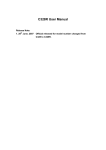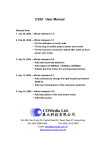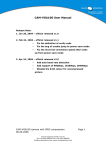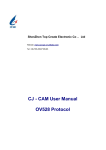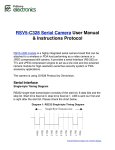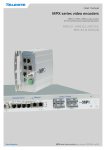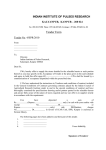Download C1182 Video Compression Module User Manual
Transcript
C1182 Video Compression Module User Manual Release Note: st 1 Release : Aug 01, 2012 www.electronics123.com C1182 USER MANUAL General Description This is a series of camera modules which perform video compression and output video stream through UART port. It can be attached to a wireless host and performing a remote video camera. Video Compression Engine VGA Image Sensor UART Host C1182 System block diagram Features Small in size 32x32mm On board VGA color sensor Lens included(option) 3.3V Operation Advance H.264 CODEC provide excellent image at low bit rate Simple and user friendly command Interface to external host via RS-232. UART: 128Kbps max for data transfer Built-in down sampling, clamping and windowing circuits for VGA(640 x480), QVGA(320x240) Power saving mode, power on by RS232 trigger Board Layout and Pin Description The module consists of 2 boards, sensor and controller board. They are interconnected by using flexible flat cable. They can be bind together by using 4 screws Sensor board: it has been designed to be mounted in standard camera house for 32x32mm PCB. Either 14mm or 20mm lens holder can be used. If use C/CS-Mount lens, just remove the lens holder and cover the holes by any means. Controller board: it can be mounted on the back of sensor board. The 4pin 1.25mm pitch board connector is provided for UART cable. Due to the high speed operation, the controller board needs more space for heat dissipation and therefore the bigger housing will be recommended. GND RxD TxD VCC Front View Pin Description VCC Power 3.3V DC TxD Data Transmit (3.3V) Rear View RxD Data Receive (3.3V) GND Power Ground Connector: 1.25 mm pitch, 4 pin single row 2 V1.0 C1182 USER MANUAL Serial Interface 1. Baud Rate C1182 use a settled baud rate 115200 bps. It can be configured to other baud rate at max 128Kb. Refer to the command set 0x01. 2. Single Byte Timing Diagram A single byte RS-232 transmission consists of the start bit, 8-bit contents and the stop bit. A start bit is always 0, while a stop bit is always 1. LSB is sent out first and is right after the start bit. Single Byte Transmission Stop Bit 7 Bit 6 Bit 5 Bit 4 Bit 3 Bit 2 Bit 1 Bit 0 Start RS-232 single byte timing diagram 3. Command Timing Diagram A single command consists of 6 continuous single byte RS-232 transmissions. Below is an example for Capture Command (AA 05 01 FF FF FF) Capture Command AA PS 05 PS 01 PS FF PS FF PS FF PS P P=Stop bit S=Start bit Command Summary 1 2 3 4 5 6 7 8 9 10 11 INITIAL DATE TIME PREVIEW CAPTURE DATA LENGTH GET DATA SYNC POWER CONTROL ACK NAK To configure the image size, quality, baud rate and packet size Send from Host the Date info for stamping purpose Send from Host the Time info for stamping purpose Command to get video frame data continuously Command to take a frame for transmission Information about the image data length Get the image data packet from module Sync the host to the module Turn off the module, all parameter reset Command to indicate the communication success Command to indicate the communication fail with error code Power control of the module The module power is controlled by UART. When power is applied to the module and UART cable is connected, the module will not operate by itself. To power on the module, issue Sync (AA08) command to turn on the module and start operation. When Power Off (AA09) command is sent, the module will cut the power and the standby current will be less than 1mA. If by accident, the host to activate the module and no other operation, the module will consume power until power disconnected. 3 V1.0 C1182 USER MANUAL Command Set The C1182 module supports total 11 commands for interfacing to host as following: Command ID Number 1. Parameter1 Image Size: Parameter2 Parameter3 Parameter4 Image Quality Baud Rate Packet Size: Initial AA01H Date AA02H YY MM DD Time AA03H hh mm ss Preview AA04H I-frame Interval Packet Interval FFH Capture AA05H FFH FFH FFH Data Length AA06H Get Data AA07H START: 01H STOP: 00H I-frame: 01H p-frame: 00H Length Byte low Packet ID low byte Sync AA08H 00H 00H 00H 00H PWR Ctrl AA09H Auto OFF : 01H Always ON : 00H ON:01H OFF: 00H 00H 00H ACK AA0Ah Command ID ACK counter FFH FFH NAK AA0Bh NAK counter Error Number FFH FFH Length Byte Length Byte mid high Packet ID FFH high byte 01H: Stamp 00H: no stamp 01H: Stamp 00H: no stamp FFH FFH INITIAL COMMAND (AA01H) The host issues this command to configure the image size, quality, baud rate and data packet size. After receiving this command, the module will send out an ACK command to the host if the configuration success. Otherwise, an NAK command will be sent out. 1.1 Image Size (Parameter 1) To define image size. Note that the bigger the image size the longer transmission time for one picture. QVGA(320 x 240) 01H VGA(640 x 480) 02H 1.2 Image Quality (Parameter 2) To define the compression rate of image. It is divided into 2 parts, I-frame and P-frame. Format: IPH where I is for I-frame and P for P-frame Compression rate can be set from 0H-FH. The bigger the number, the higher compression or smaller image size. Higher compression will result the poor image quality. 1.3 Baud Rate (Parameter 3) Default baud rate is 115.2Kb but user can set this to other baud rate after connection. After change, user needs to change host baud rate before connection. 128Kb 115Kb 57.6Kb 38.4Kb 19.2Kb 14.4Kb 9.6K 4 01H 02H 03H 04H 05H 06H 07H V1.0 C1182 USER MANUAL 1.4 Packet Size (Parameter 4) C1182 can support 4 different Data Packet Size as below: 512 Bytes 2048 Bytes 4096 Bytes 8192 Bytes 01H 02H 03H 04H The host issues this command to change the size of data packet which is used to transmit image data from the C1182 to the host. This command should be issued before sending Capture command or Get Data command to C1182. 1.4.1 Data Packet Content (For Capture Command): Byte 0 Byte (N-1) Packet Size ID (2 bytes) Low byte, high byte ID Data Size Image Data Reserved Verify Code Data Size (2 bytes) Low byte, high byte Image Data (Packet size – 8 bytes) Reserved (2 bytes) 0xFFFF Verify Code (2 bytes) Low byte, high byte -> Data Packet ID, starts from 0000h to F0F0h -> Actual size of available image data in the packet -> Available image data -> 0xFFFF -> Error detection code, equals to the lower byte of sum of the whole data packet except the verify code field. The higher byte of this code is always zero. i.e. verify code = low byte(sum(byte[0] to byte[N-3])) N = packet size Note: The size of the last data packet varies for different image. 1.4.2 Data Packet Content (For Preview Command): Byte 0 Packet Size Start Code (2 bytes) Low byte, high byte Image Data (Packet size – 4 bytes) Start Code -> 2-byte start code (0xAA55) Image Data -> Available image data End Code Byte (N-1) End Code (2 bytes) Low byte, high byte -> 2-byte end code (0x55AA) 5 V1.0 C1182 USER MANUAL 2. DATE COMMAND (AA02H) C1182 can accept date time stamp on the image. By default D/T stamp is off, parameter 4 = 00H User can select stamp either date or time or both. Data time info will be stamped on the right hand bottom of the image. This command is in YYMMDD format, differ from other hexadecimal. Date time info will keep update as long as the module is powered. Command format: e.g. To input date of Dec 25, 2011, stamp on AA 02 11 12 25 01 (Note: this is only good for VGA resolution video.) 3. TIME COMMAND (AA03H) Time display is in 24Hr format. Again, this command is in HHMMSS format, differ from other hexadecimal. Command format: e.g. To input time of 12:30:00, stamp off AA 03 12 30 00 00 (Note: this is only good for VGA resolution video.) 4. PREVIEW COMMAND (AA04H) Host to issue this command for capturing a sequence of I-frame or P-frame continuously. Once the host issues this command, the module will send out the data packets continuously, without any handshaking command in between. In this case, the amount of command-data overheads and also the CPU loading at the host side can be reduced. Due to the nature of this uncontrolled data transmission, it is the host’s responsibility to handle the received data packet in a right timing and manner. 4.1 START/STOP (Parameter 1) To start (01H) or stop (00H) the preview operation 4.2 I-frame Interval (Parameter 2) To set the number of P-frames to be inserted between successive I-frames, e,g. 00H – IPPPPP …………. (first I-frame and then all P-frames) 01H – I I I I I I I …………. (all I-frames) 02H—IPIPIPIP……. 03H – IPPIPPIPP…. etc ……. 4.3 Packet Interval (Parameter 3) To set the minimum time interval between each packet transmission. It can be used to control the data rate of the video stream sending out from the module. 00H -- 0 ms. The next packet will be sent out immediately after the current packet is sent. 01H -- ~2*(1) = 2 ms 02H -- ~2*(2) = 4 ms ….. FEH - ~ 2*(254) = 508 ms FFH - ~ use system default 5. CAPTURE COMMAND (AA05H) Host to issue this command for capture either I-frame or P-frame, such case, video format can be all I-frame or any combination of I-P frame, such as IPIP, IPPIPP etc. C1182 will send out an ACK command and Data Length command to the host if the operation success. Otherwise, an NAK command will be sent out. 6 V1.0 C1182 USER MANUAL 6. DATA LENGTH COMMAND (AA06H) C1182 issues this command for telling the host the size of the image data which is ready for transmitting out to the host. These three bytes (LOW, MID, HIGH) represent the length of the image data. User needs to calculate the number of packets by using this length data. 7. GET DATA COMMAND (AA07H) The host can issue this command to request image data packet with desired packet ID after receiving Data Length command from C1182. 7.1 After receiving this command, C1182 will send a data packet to the host. The details about the content of the data packet please refer to the previous page in the manual. Packet ID Data packet ID, starts from 0000h to F0F0h. Package ID 0000h 0001h 0002h 0003h …… F0F0h 7.2 Command AA 06 00 00 FF FF AA 06 01 00 FF FF AA 06 02 00 FF FF AA 06 03 00 FF FF …… AA 06 F0 F0 FF FF Packet Number Number of packet = Image size / (Packet size – 8) 8. SYNC COMMAND (AA08H) The host needs to send this command to sync with C1182 when power up. 9. PWR CTRL COMMAND (AA09) C1182 has no sleep mode but auto off mode to save power. By default it is auto off mode, user can turn this mode on or off by setting the parameter of this command. 9.1 Turn on/off the auto off mode The module has built in timer to turn off itself if system idle more than 30sec. To turn off this feature, issue this command and set parameter 1 to 00H, such case, the module will be ON forever until power removed or receiving force power off command. Command format: e.g. Turn off the auto off feature AA 09 00 01 00 00 9.2 Power off the module User can turn off the module immediately after operation completed to save power by sending parameter 2 of 00H. It doesn’t care what the power mode is. Command format: e.g. Turn off the module any time AA 09 xx 00 00 00 10. ACK COMMAND (AA0AH) This command indicates the success of last operation. After receiving any valid command, ACK command must be sent out except when getting image data. 10.1 Command ID The command with that ID is acknowledged by this command. 10.2 ACK Counter ACK counter, indicates the amount of ACK 7 V1.0 C1182 USER MANUAL 11. NAK COMMAND (AA0BH) This command indicates corrupted transmission or unsupported features. 11.1 NAK Counter (Parameter 1) NAK counter, indicates the amount of NAK 11.2 Error Number (Parameter 2) Number Description 01H Parameter 1 error 02H Parameter 2 error 03H Parameter 3 error 04H Parameter 4 error 05H Command ID error 06H Picture not ready 07H Packet ID error 8 V1.0 C1182 USER MANUAL Command Protocol SYNC Command Before the host to talk to module, host needs to send SYNC command until receiving ACK command from the module. If connection is good, usually, ACK command will be received within 10times of SYNC command SYNC AA 08 00 00 00 00 HOST : : : C1182 ACK (AA 0A 08 01 FF FF) SYNC (AA 08 00 00 00 00) ACK AA 0A 08 02 FF FF Synchronize complete. Example 1 – capture a QVGA image Below is an example of getting a QVGA image, at baud rate 115Kb, packet size of 2KB with date/time stamping on the picture, power off the module after completion. 1. Initial Command Initial QVGA, i-Q 8, p-Q 8, 115K, 2048 bytes (AA 01 01 88 02 02) HOST ACK (AA 0A 01 01 FF FF) 2. C1182 Date/time Command Date (AA 02 11 12 25 01) ACK (AA 0A 02 02 FF FF) Time (AA 03 12 30 00 01) ACK (AA 0A 03 03 FF FF) 3. Capture I frame Capture (AA 05 01 FF FF FF) ACK (AA 0A 05 04 FF FF) Data Length (AA 06 ~~ ~~ ~~ FF) 9 V1.0 C1182 USER MANUAL 4. Get Data Get Data Packet ID: 0001h (AA 07 01 00 FF FF) Data Packet ( 2048 bytes) : : Get Last Data Packet ID: XXXXh (AA 07 XX XX FF FF) Last Data Packet 5. Capture P-frame Capture (AA 05 00 FF FF FF) ACK (AA 0A 05 xx FF FF) Data Length (AA 06 ~~ ~~ ~~ FF) Get Data Packet ID: 0001h (AA 07 01 00 FF FF) Data Packet ( 2048 bytes) : : Get Last Data Packet ID: XXXXh (AA 07 XX XX FF FF) Last Data Packet 6 Repeat 4 or 5 to get more I-frame or P-frame 7 Power off the module PWR CRT (AA 09 xx 00 00 01) ACK (AA 0A 08 xx FF FF) Turn off module 10 V1.0 C1182 USER MANUAL Example 2 – Preview VGA image Below is another example to preview a VGA image, at baud rate 115Kb, packet size of 2KB, insert 30 P-frame between two I-frames, without date/time stamping on the picture, and stop the preview after some time. 1. Initial Command Initial VGA, i-Q 8, p-Q 8, 115K, 2048 bytes (AA 01 02 88 01 02) HOST ACK (AA 0A 01 01 FF FF) C1182 2. Date/time Command Date (AA 02 xx xx xx 00) ACK (AA 0A 02 02 FF FF) Time (AA 03 xx xx xx 00) ACK (AA 0A 03 03 FF FF) 3. Start Preview Preview Start (AA 04 01 31 FF FF) ACK (AA 0A 04 04 FF FF) Data Packet ( 2048 bytes) : : 4. Stop Preview Preview Stop (AA 04 00 xx FF FF) ACK (AA 0A 04 05 FF FF) 11 V1.0












